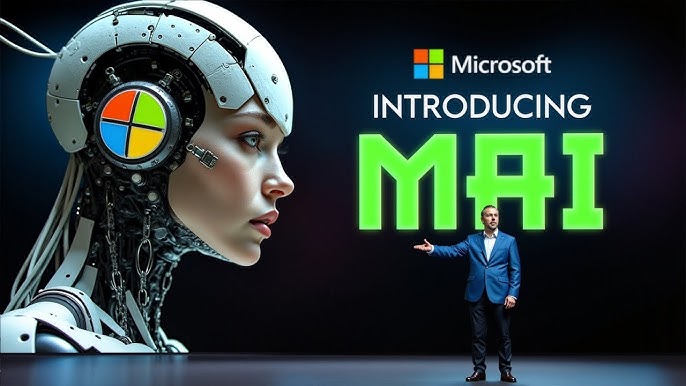In a major leap for artificial intelligence innovation, Microsoft AI has officially launched its latest text-to-image generation model, MAI-Image-1, aimed at challenging leading tools from Google and OpenAI.
This launch comes amid the rapidly intensifying AI race, where companies are pushing boundaries in generative visual content. Microsoft’s new tool marks its most ambitious move yet in the creative AI segment, following the success of its earlier MAI-Voice-1 and MAI-1-preview models.
About Microsoft’s MAI-Image-1
The MAI-Image-1 model was designed in close collaboration with professional artists, designers, and visual creators to overcome a common challenge seen in other AI tools — repetitive, unrealistic, or overly stylized results.
According to Microsoft, the new AI model produces highly photorealistic images that excel in fine details such as lighting, textures, and natural landscapes. Its superior image rendering capability positions it as a potential game-changer for industries ranging from digital marketing and design to film, gaming, and education.
One of the standout features of MAI-Image-1 is its speed and efficiency. Microsoft claims the system can process user prompts and generate images faster than competing models, all while maintaining high-quality output.
The model’s performance has already gained recognition — MAI-Image-1 has been ranked in the top 10 globally on LMArena, a respected AI benchmark platform where human evaluators rate and compare image-generation systems from various tech companies.
How MAI-Image-1 Stands Out
Microsoft’s latest model is built to deliver creativity without compromise. By integrating deep learning techniques with refined image synthesis algorithms, the company says it has achieved a balance between speed, realism, and stylistic diversity — a combination often lacking in AI-generated visuals.
Unlike many AI tools that struggle with lighting effects, realistic skin tones, or complex backgrounds, MAI-Image-1 reportedly handles such challenges with ease. This allows users — from content creators to enterprise designers — to generate studio-quality visuals instantly, without needing post-editing or corrections.
“Our focus with MAI-Image-1 is to empower creators with faster, safer, and more lifelike AI visuals,” Microsoft said in its announcement. “This model represents the next step toward creative AI systems that understand artistic intent while maintaining responsible boundaries.”
Microsoft’s Broader AI Strategy
The introduction of MAI-Image-1 reinforces Microsoft’s strategy of building a diverse ecosystem of proprietary AI models. The company has been steadily expanding its portfolio with tools like MAI-Voice-1 for text-to-speech generation and MAI-1-preview, a conversational chatbot that rivals OpenAI’s ChatGPT.
Interestingly, this development comes as Microsoft continues to balance its relationship with OpenAI, a company it has heavily funded and collaborated with. At the same time, Microsoft has also partnered with Anthropic — another AI research firm — to integrate Anthropic’s models into select Microsoft 365 products.
By investing in both internal AI model development and external partnerships, Microsoft aims to create a flexible, multi-model AI ecosystem that can cater to varied use cases — from enterprise productivity and cloud computing to consumer creativity.
Safety and Ethical Use of AIIn line with growing global scrutiny over the ethical use of AI, Microsoft has emphasized that MAI-Image-1 comes with advanced safety guardrails. These include strict filters to prevent the creation of inappropriate or harmful content, as well as bias-mitigation frameworks to ensure fair and inclusive image generation.
“We remain deeply committed to developing AI systems that are safe, transparent, and beneficial to all,” Microsoft stated, reiterating its alignment with responsible AI principles.
Independent testing and third-party evaluations of MAI-Image-1 are expected in the coming weeks, which will provide further insights into the model’s capabilities and reliability.
AI Race Heats Up
The launch of MAI-Image-1 adds another dimension to the AI rivalry among Microsoft, Google, and OpenAI. Google’s Nano Banana AI image tool recently gained viral attention for its creative and surreal visual outputs, while OpenAI continues to lead the space with its DALL·E series.
With MAI-Image-1, Microsoft aims to bridge the gap between artistic control and AI automation, offering creators a reliable tool that can handle both professional and experimental visual projects.
Conclusion
Microsoft’s MAI-Image-1 represents a significant stride in the company’s AI journey — combining speed, realism, and responsible innovation. As businesses and creators increasingly rely on generative AI for visual storytelling, Microsoft’s latest tool could redefine how digital imagery is produced, shared, and experienced.
With its growing suite of AI models and strong focus on ethical design, Microsoft is positioning itself as a serious competitor in the global AI landscape, directly taking on Google and OpenAI in the race for next-generation creative intelligence.

